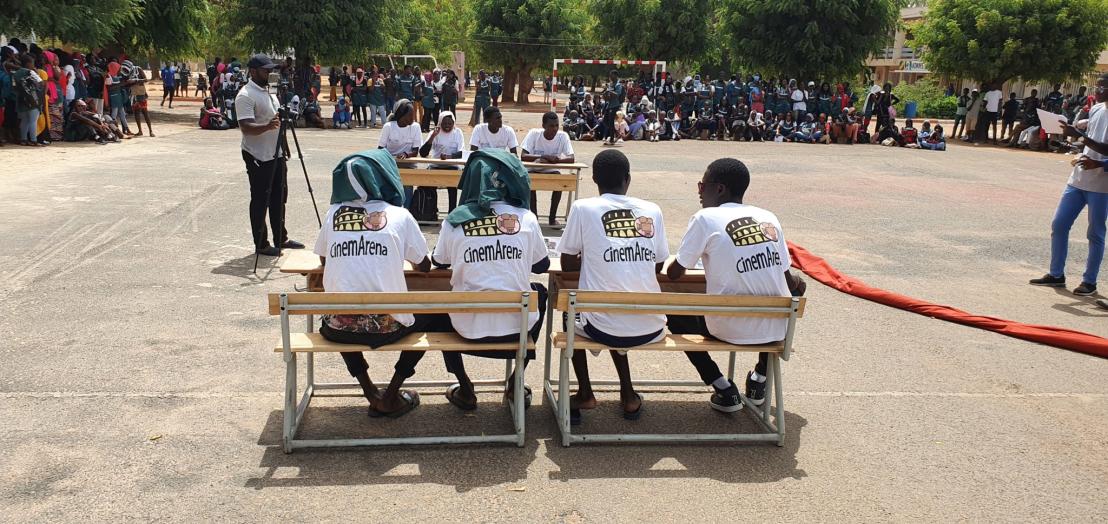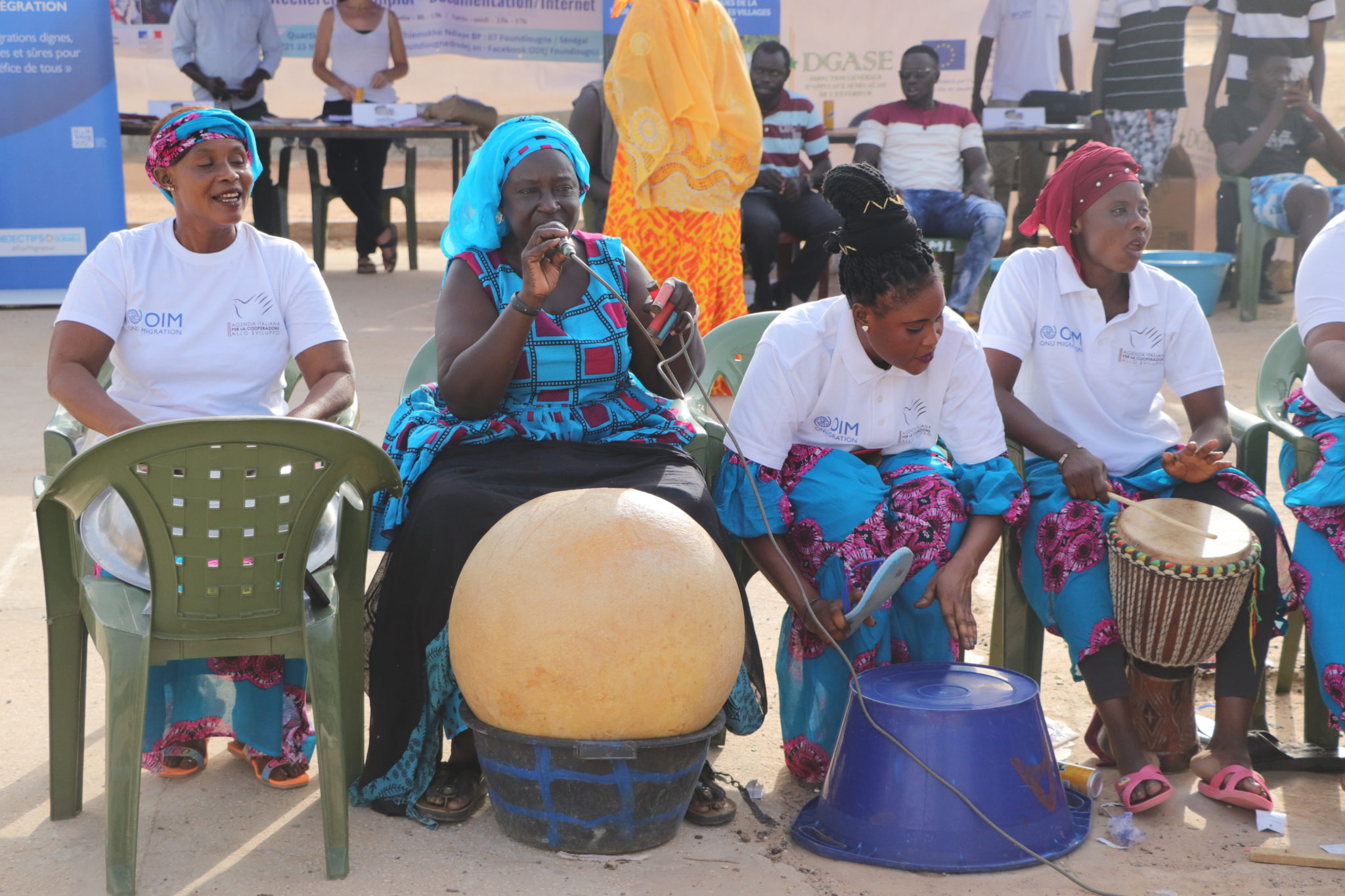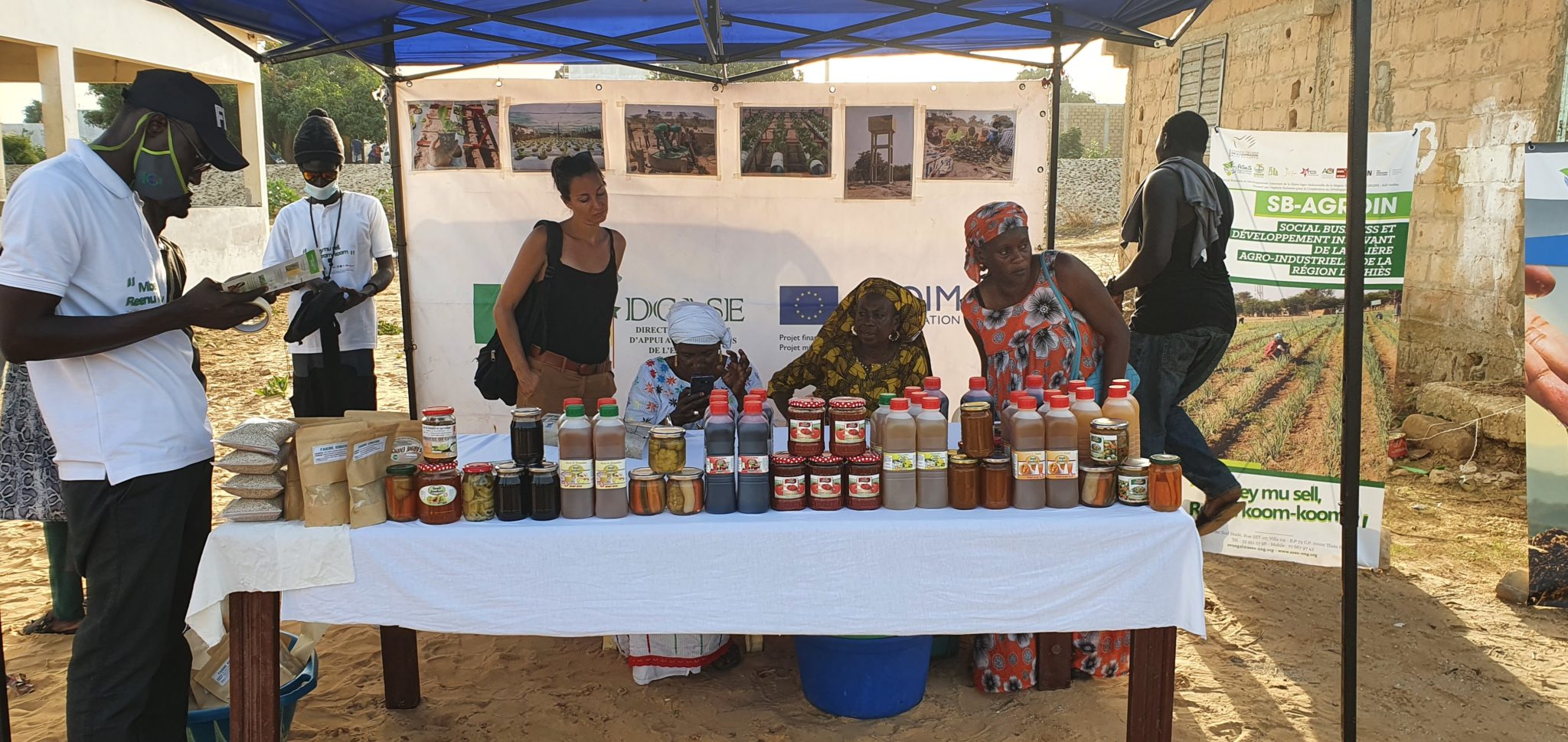
Students from Malick Sy school in Thiès competing in the CinemArena quiz / IOM – Marianne Anna DIOH
In and earlier article, we explained how IOM uses mobile cinema as part of its activities. This post gives some more detail on how you can organise your own public screening event.
CinemArena
Funded by the Italian Ministry of Foreign Affairs with the support of the Italian Agency for Development Cooperation, CinemArena is a mobile cinema project implemented by IOM in West Africa.
It is a mobile cinema featuring a series of outdoor events, both in rural and urban areas, where films, documentaries and testimonies are screened. The aim of the project is to inform and educate about social issues in very remote places, often cut off regular communication channels. This is carried out in different and complementary ways:



Let’s take a step by step approach on how a caravan comes to be.
The Preparation
1. Coordination with central and local authorities, organization of visits to identify screening sites and recruitment of partners
To organize public screenings you need to inform local authorities in advance of your arrival. The team should involve local partners in the planning of events, identifying the appropriate locations and recruiting local providers in charge of running the activities.
To do this, start by sending an official letter to the governor of the region where the screening will take place specifying the content and purpose of all planned activities. We recommend to pay authorities a visit in the weeks leading up to the event. This will motivate them and feel more involved. Don’t neglect traditional authorities who are close to the population and can help mobilize large groups to participate.
You will not be able to manage all the aspects of the screening without logistical support. Source for local providers who can help with:
- a suitable projection space in collaboration with the local authorities; it should be spacious, public and central
- security measures for the staff and for the public: the team should have a first aid kit and telephones and/or GPS available, including security guards and escorts in potentially risky areas
- logistics support for the open-air screening such screening equipment (giant screen, podium, sound system, light and generator, microphone and any other accessories for open-air screenings), rental of chairs, barriers, mats and tents as well as sanitary kits
- transport for the equipment and people to the location hosting the event, if necessary
- inform local youth, migrant and women’s associations
Read our article on the importance of local sourcing, and try to find facilities in your locality with experience in organizing public screenings. Do not hesitate to carry out a visit to the venue with the provider to assess the feasibility and any problems that should be anticipated.
2. Involve Facilitators and Artists
Another aspect to consider in this preparation process is the involvement of volunteers or facilitators in the activity. It is preferable that the volunteers or facilitators recruited are local residents and are trained or used to attend this type of event. Volunteers are connected to their communities. They will support you from start to finish, not only mobilizing the population but also facilitating most of the activities in local languages.
The field projection should be combined with fun activities (dance and theatre shows, musical performances, games, etc.) to attract the spectators and catch their attention. When choosing performers, it is suggested that you engage the locals to give your message a greater impact.
3. Film Selection
To give impact to your message, prioritize local productions that reflects the realities of the area, and choose short films to catch the audience’s attention as much as possible. We recommend keeping the screenings short and allowing more time for discussion and exchange, as this will reinforce your message. The content is also an important aspect to consider, it should be easy to understand and adapted to all ages, particularly the youngest.
4. Promotion
Use all the communication channels available to you to promote your activity (press conference, broadcasting of spots on local radio and television stations, publications on social media, etc.).
Day Of The Activity
Activities should ideally be done at the end of the day when community members are available and can attend. Hours should be agreed with the local authorities to avoid disruption as there are some areas that do not allow night-time events.
Installation of the screening van in Bayakh, Thiès / IOM – Marianne Anna DIOH
Once you have selected the location and set up a program of activities in advance, plan with the local service provider to start installing the projection equipment. This includes:
- A mobile van equipped with projection equipment with a giant screen;
- A podium, chairs, tents, mats and barriers;
- Sound and light equipment;
- A generator.
The installation must be done 3 hours before the beginning of the activity and thus be immediately followed by a musical animation to attract the crowd.
SB-AGROIN, a local partner of the CinemArena caravan specialising in the production of local products in Thiès / IOM – Marianne Anna DIOH
Tents are also installed nearby to allow local partners such as training schools, local manufacturing companies, public employment promotion offices or local craftsmen to set up stands. Participants will be able to go there to find out about local opportunities.

Performance of traditional singers in Foundioune, Fatick / IOM – Lygali Grâce Marvel Fleurdin DISU
To encourage people to take part in activities, start the event with cultural activities specific to the locality you are visiting (parade of traditional dress, traditional songs, dance competitions for children with goodies as prizes).
Afterwards, a welcome speech may be delivered by the Governor, the Mayor, the Prefect, the Village/District Chief, the community relays, a representative of a youth or migrant association, and an IOM staff member who explains the project and its objectives. This will be followed by the presentation of the program and the different speakers who will be taking the floor.
As part of your activities, you can organize a theatre piece on the theme of migration in local languages to be performed by young people from the locality. The performance will be followed by a screening of a series of short awareness-raising videos, if you cannot find videos in local languages, consider dubbing the content into the local language, or select those with meaningful and understandable images that will reach many people.
The facilitator initiates discussions at the end of the screenings to allow participants to comment or debate on what they have watched. One aspect that should not be forgotten is the testimony of the returnees, which allows attendees to really appreciate what these people have endured and to better facilitate their reintegration into the community, as well as giving credibility to your message. You can conclude in a fun way by inviting local artists for performances.
As mentioned earlier, getting the local authorities involved can ensure the sustainability of the project as they can use this model to organize such activities on their own.
After The Activity
Remember to organize an evaluation meeting with all the participants (service provider, volunteers, staff, authorities) to discuss the difficulties experienced and the various solutions that can be proposed for the future organization of similar events.
Recommendations




